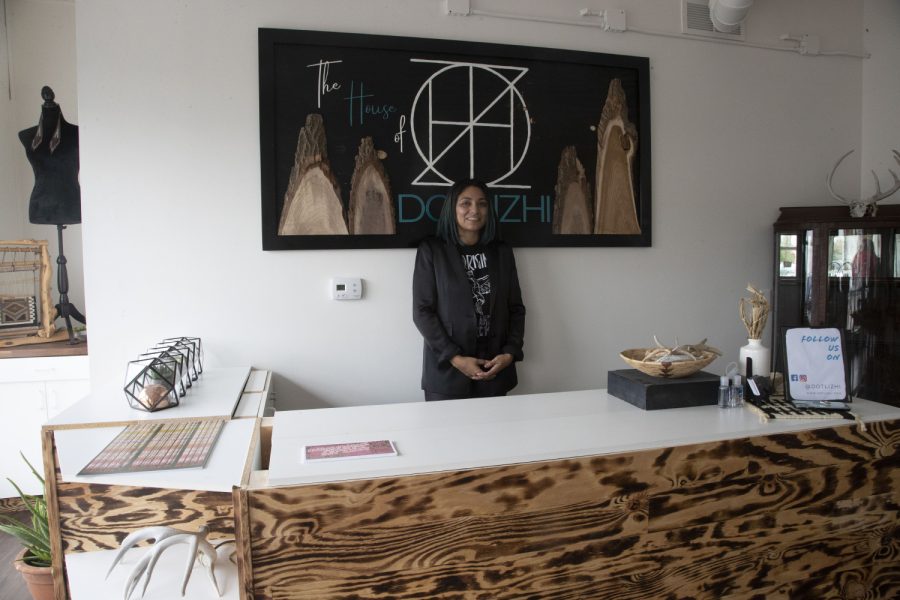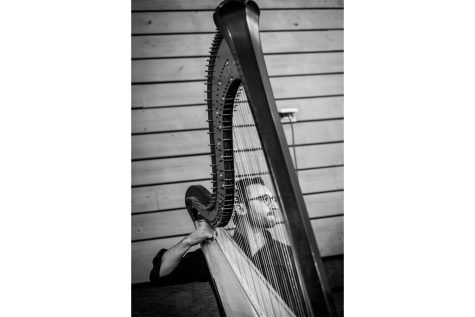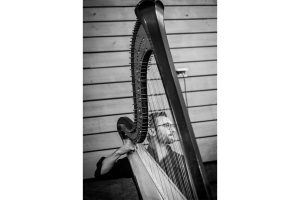Iowa City’s first Indigenous woman-owned business fuses art, fashion, tradition, and healing
Indigenous woman Alicia Velasquez is “bringing a little Southwest to the Midwest ” with her new gallery, boutique, and studio, The House of DOTŁ’IZHI. The space on Kirkwood Ave. will double as a site to find ethically sourced art and fashion made by Indigenous Iowan artists, and community and healing.
The House of DOTŁ’IZHI is a jewelry and an indigenous people art gallery owned by Alicia and located in Iowa City opening on Monday, November 1st.
October 28, 2021
Artist and designer Alicia Velasquez maneuvered her new space on Kirkwood Avenue swiftly and intentionally, finalizing the last details for her store’s opening on Monday.
The Apache woman, dressed in all black with shoulder-length turquoise hair, is the owner of what will be Iowa City’s first Indigenous woman-owned business, The House of DOTŁ’IZHI, a boutique, studio, and gallery that will house works by Indigenous Iowa artists.
DOTŁ’IZHI (pronounced Dot-Cluh-Gee) is the Apache word for turquoise, a stone that for Velasquez, represents three important aspects of womanhood: strength, beauty, and worth.
The name received quite a bit of pushback, Velasquez said. People warned her it would be too hard to pronounce. To this, she wondered why it was that names like Louis Vuitton, Chanel, and other international brands became learned and accepted, but not one originally from the Americas.
“So that’s where I said, no, if that means I have to DOTŁ’IZHI until I turn blue, I’m going to do it,” Velasquez said.
Though the initial idea for the space was to be Velasquez’s personal studio for her handmade bead and metalwork, she quickly realized the need for the space extended beyond her own.
Velasquez said she initially noticed the lack of Southwestern art and fashion presence in Iowa City when she moved from Oklahoma in December. She knew she had the means to fill this gap by displaying with her art and the art of other Indigenous artists.
RELATED: UI artist channels life’s adversities into jewelry
In general, Velasquez said, artists just want to create; they don’t want to have to worry about the business side of things. Velasquez said she’s fortunate enough to understand the business side, while also being an artist. She will be taking only 20 percent of the cut from artists’ sales in her store — a number unheard of in customary consignment.
“I want to make it as easy as possible for them and I don’t want to make it hard because, why? There’s no need,” Velasquez said. “I just need to sell two rings and I’ll make rent, you know, and that’s fine with me. But these other artists, the reason why they’re not out there is because they can’t afford it. And they need to put food on the table, so I’m not gonna take that from them.”
The space is modern, but upon closer review, reveals a thoughtful arrangement steeped in tradition, sustainability, and personality.
The marbled wood countertops were burned by Velasquez and her husband, and the drawings on a back table were created by her 21-year-old daughter. The vase that sits between the drawings is a 100-year-old wire basket from her tribe, gifted to her by a white, Iowa Citian stranger — one that would retail for around $4,000-$5,000.
“He could have made money off of it, but he’s like, ‘No, I’m gonna give it to you,’” Velasquez said. “So that’s a huge, huge, huge gift, blessing, however you want to call it. So just having stories like that of other cultures coming in — if I can buy back some of these artifacts to give back to the tribe, I mean, that’s huge.”
In the center of the room is the space’s focal point: Velasquez’s handmade jewelry. Fusing unique designs with traditional techniques, each pair of earrings and necklaces have been made sustainably; each stone on the rings locally hunted, cut, and polished by an independent lapidarist, and welded by Velasquez in the back room of DOTŁ’IZHI.
In Apache tradition, beadwork is known for its healing and medicinal properties. Alicia Velasquez grew up watching her father sit by his bedside table and work with the beads to ease his symptoms of PTSD.
Now, at 42, Velasquez looks back to her early adulthood, recalling when the practice escaped her. In 2002, she was a young, overwhelmed mother — two of her four children had been diagnosed with autism, and she lost herself. Velasquez left the workforce for 14 years to take care of her children, and then worked as a makeup artist for seven years before returning to her practice.
“When I was going through my issues, my depression, my trying to figure out what’s going on — because having two kids with autism was so hard, having kids in general — I got back into beadwork, and I saw that, okay, that was helping healing me, and putting my mind someplace else,” Velasquez said.
Along her path, in the various places she’s lived, Velasquez has intersected with elders from her tribe who wished to continue cultivating the practice her dad had begun years ago. The time they invested into her beadwork and metalwork techniques was given in hopes of keeping their long-standing traditions alive.
RELATED: Beadology holds 10th Annual Bead Challenge
In the jewelry she makes now, Velasquez said she tries to add a level of modernity that will enable people of all cultures to feel comfortable wearing the pieces. She hopes to soon extend the business to carry clothing and home decor as well, essentially making it a full fashion house. Additionally, she wants to provide a beading circle.
“What that is, culturally, we would go to our grandmother’s house, or Auntie’s houses, and sit around the kitchen table, gossip, talk smack — and we’re beadworking, laughing and enjoying one another,” Velasquez said. “And so I want to bring that cultural experience back here and open it up not just to Native women, or men, but also other cultures because if you look at it, every culture has a form of beadwork.”
According to Velasquez, the mission of The House of DOTŁ’IZHI is not strictly selling and making money, but helping her native community get exposure, and enlightening people to the reality that Indigenous women are more than hair feathers and nude bodies.
“My goal is to teach women and express to women of all ages to know your strength, beauty, and worth because you are beautiful regardless of your shape, size, skin color. You are strong,” Velasquez said.
On Monday, the public is invited to celebrate The House of DOTŁ’IZHI opening with Velasquez and her family with traditional fry bread and giveaways. More information can be found on The House of DOTŁ’IZHI website.


















